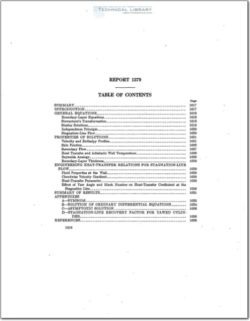NACA-Report-1379

- Version
- 175 Downloads
- 3.86 MB File Size
- 1 File Count
- December 4, 2015 Create Date
- December 4, 2015 Last Updated
National Advisory Committee for Aeronautics, Report - Compressible Laminar Boundary Layer Over a Yawed Infinite Cylinder with Heat Transfer and Arbitrary Prandtl Number

The equations are preser for the development of the
compressible laminar boundary layer over a yawed infinite
cylinder. For compressible flow with a pressure gradient the
chordwise and spanwise flows are not independent. Using
the Stewartson transformation and a linear viscosity-temperature
relation yields a set of three simultaneous ordinary difi‘erential
equations in a form yielding similar solutions. These equations
are solved for stagnation—line flow for surface temperatures
from zero to twice the free-stream stagnation temperature and
for a wide range of yaw angle and free—stream Mach number.
The results indicate that the efi'ect of yaw on the heat-trawler
coeflicient at the stagnation line depends markedly on the free-
stream Mach number. For subsonic Mach numbers the
decrease in heat-transfer coeflicient with yaw angle A is about
w/cos A, which is the decrease for incompressible flow. How
ever, for free-stream Mach numbers greater than approximately
9, the variation in heat-transfer coefiicient with yaw angle is
somewhat less than cos A except when the normal component of
the stream Illach number is subsonic; then the variation tends
to approach V cos A. This decrease in heat-transfer coef-
ficient with yaw angle is practically independent of wall
temperature and Prandtl number for the values of these param-
eters used in the present calculations. The recovery factor,
defined in terms of the local external temperature, can be
approximated as the sguare root of the Prandtl number for the
range of yaw angle, Mach number, and Prandtl number,
included in the calculations.
An unusual result of the solutions is that for large yaw
angles and stream Mach numbers the chordwise velocity within
the boundary layer exceeds the local exteer chordwise velocity,
even for a highly cooled wall.
As flight speeds are increased, the problem of aerodynamic
heating becomes more serious, and the temperatures of
critical areas such as the nose of an aircraft or the wing
leading edge may exceed the design specifications. An
accurate knowledge of the laminar-boundary—Iayer charac-
teristics then becomes desirable, not only for predicting heat-
transfer rates, but also for calculating the stability of the
boundary—layer flow.
| File | Action |
|---|---|
| naca-report-1379.pdf | Download |

Comment On This Post